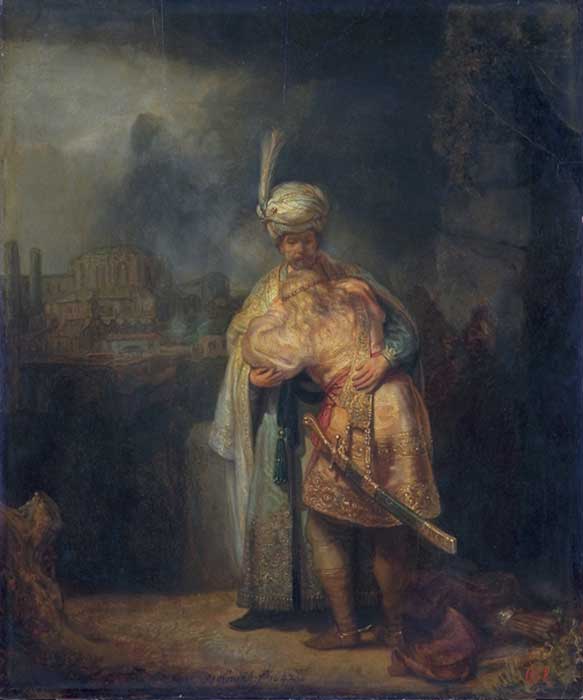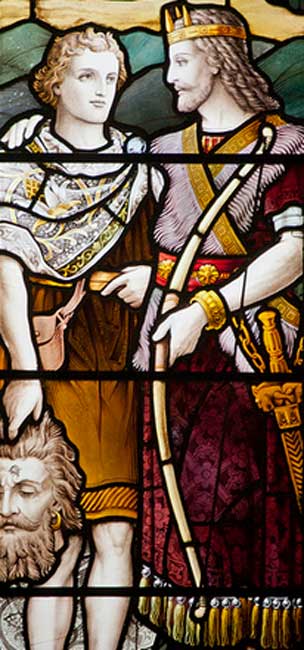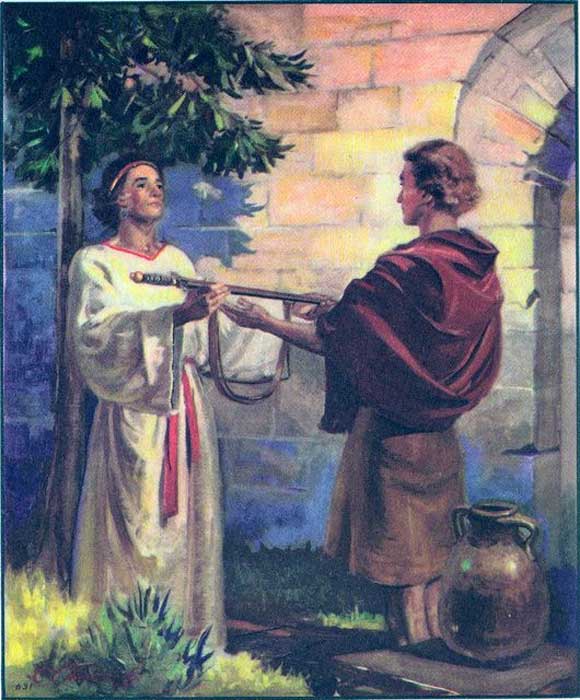The deep, emotional relationship that bonded David and Jonathan is related in the books of Samuel. The two are said to have formed a covenant of friendship, even though their situation essentially made them rivals for the crown. But was theirs a strong platonic relationship, or an example of homosexuality in the Bible?
The Relationship Between David and Jonathan
In the Bible, Jonathan is the eldest son of King Saul of Israel. He is described as strong, swift, and a talented archer. For his part, David is best known for his defeat of the giant Goliath. He is depicted as a skilled warrior, poet, and musician and is part of the tribe of Judah and the son of Jesse of Bethlehem.
When God became angry with Saul for an undesired sacrifice, he had the prophet Samuel anoint David to be king instead of the rightful heir, Jonathan. Although this basically made Jonathan and David competitors for the throne, the two men were on friendly terms and it was David who became king, with Jonathan’s support.

Gottfried Bernhard Göz: Jonathan greeting David after David killed Goliath. ( Public Domain )
The friendship between David and Jonathan is one that is held up by many Bible scholars as a good example of male bonding between heterosexual men. Jonathan and David were good friends in spite of the jealousy of King Saul , and Jonathan even went out of his way to protect David from Saul’s jealousy and selflessly acknowledged David as the rightful king of Israel – even though it meant giving up his future throne.

David and Jonathan (1Sam. 20:42) ( Public Domain )
Dialogues of Friends or Lovers?
This devotion between Jonathan and David has been interpreted by some in recent decades to suggest a homosexual relationship. This discussion has become more heated recently because of the major controversy which has arisen both within and outside the Church over whether homosexuality is permissible according to the Bible. The preponderance of the evidence shows that although David and Jonathan were close, their intimacy was not unusual for heterosexual male friends in that culture – leaving insufficient reasons to suggest any sort of romantic relationship between them.
However, one of the main arguments used in favor of romance between them is the strong language used to describe their relationship. The Biblical text says that their souls were “knit together” and that Jonathan loved David “as his own soul (1 Samuel 18:1-3).” Furthermore, David tells Jonathan on their final departure that his relationship with Jonathan was better than that of a woman (2 Samuel 1:26).

David and Jonathan ( 1642). ( Public Domain )
Although this sounds odd to Westerners, it would not have been out of place in dialogue between heterosexual male friends in the ancient Near East, where stronger language and exaggeration tend to be used in describing intimate non-romantic and non-sexual relationships. A modern example would be pictures of male Middle Eastern leaders kissing each other on the cheek. This is not a sign of romantic involvement between them but rather the equivalent to a warm handshake.
Abraham Rihbany, a Bible scholar who was also a native of the Levant (Syria, Palestine, and Jordan), being Lebanese, in his book, The Syrian Christ , recounts how men in the Middle East act towards their heterosexual male friends. He describes words and behavior that are very similar to those used by David and Jonathan towards each other.
Rihbany is a New Testament scholar talking about 1st century Palestine, but in many ways the 11th century BC was not very far removed from the 1st century AD. Even today, Middle Eastern people are still as affectionate and colorful with their words as they were at the time of Christ two thousand years ago. Thus, it is not unreasonable to suggest that they were the same way a thousand years before Christ.

David and Jonathan in St Giles Cathedral, Edinburgh. (Lawrence OP/ CC BY NC ND 2.0 )
Gestures of Affection and Politics
Another specific case that is used to argue that David and Jonathan were romantically involved is where Jonathan takes off his armor and robe and puts them on David (1 Samuel 18:4). Some have suggested that this is a sexual encounter. The main problem with this idea is that Jonathan is the only one taking off his clothes. It is more likely that Jonathan is simply giving David his armor.
Some still argue that this is a sign of romantic affection since Jonathan essentially gives David everything, including his right to the throne, in this gesture. However, the Biblical background of this event is that David had earlier been anointed king of Israel and thus it was David, not King Saul’s son Jonathan, who was the rightful heir to the throne.
Hence, all Jonathan is doing by giving David his right to the throne through offering him his robe and armor is acknowledging that Yahweh has made David the rightful king. This might also be a gesture of friendship or affection, but it is mainly a political and religious gesture. No romantic interpretation is necessary.

Jonathan gives David his robe, armor, and weapons. ( CC BY NC )
Were David and Jonathon Married?
Another line of evidence that has been brought up by proponents of this hypothesis of a romantic relationship between David and Jonathan, such as the scholar Jeremy Townsley, is that there is a passage (1 Samuel 18:21) which says that when Saul gave his daughter’s hand in marriage to David, he said for a second time that David would be his son-in-law.
Townsley interprets this as saying that David was already in a same-sex marriage with Jonathan, since David only had a relationship with two of Saul’s children, his daughter Michal and Jonathan. A closer analysis of the original language in the text, however, shows that Saul is saying that David will become his son-in-law because of his second daughter not that he will become his son-in-law a second time, which makes a second marriage explanation unnecessary.
Another issue with this argument is that had David and Jonathan been married, either Jonathan would become a member of David’s house or David would have become a member of Jonathan’s house. Neither would have been what King Saul would have wanted.
He wanted a king who was a member of his lineage to be on the throne of Israel. Something which would not be possible in the case of Jonathan becoming king if he was already in the house of David. Also, he would not have wanted David to be a member of his house since he considered David his mortal enemy. A marriage between David and Jonathan would have been very problematic politically and it was therefore unlikely.

Saul tries to kill David. ( Public Domain )
Is it All Just a Modern Misunderstanding?
As homosexuality becomes more mainstream in Western culture, there have been increasingly more attempts to neutralize divides between Christianity and the modern West on this issue by saying that the Bible does not actually condemn same-sex romantic relationships, only certain instances – such as those involved in pagan rituals or pederasty.
Unfortunately for those who want to say that the Bible does not forbid homosexuality, the arguments for positively portrayed same-sex romantic relationships in the Bible tend to be based on a misunderstanding of the cultural context or otherwise anachronistic.
It is possible that the Biblical position on homosexuality is more complex than previously thought, but those who want to argue this case must do it with rigorous quality research and a good understanding of the cultural, social, and linguistic background of Biblical text.

Biblical Prince Jonathan and David embrace. Manuscript illustration of La Somme le roy, ca. 1300 AD. ( Public Domain )
Top Image: David and Jonathan. Source: Public Domain
By Caleb Strom
Updated on November 10, 2021.
 RSS Feed
RSS Feed















 November 11th, 2021
November 11th, 2021  Awake Goy
Awake Goy  Posted in
Posted in  Tags:
Tags: 













